This article needs additional citations for verification .(June 2020) |
Landmarks is the public art program of The University of Texas at Austin. Its projects are exhibited throughout the university's 433-acre main campus.
This article needs additional citations for verification .(June 2020) |
Landmarks is the public art program of The University of Texas at Austin. Its projects are exhibited throughout the university's 433-acre main campus.
Landmarks grew out of a 2005 policy, Art in Public Spaces, [1] that was approved by The University of Texas System Office of the General Counsel and the Executive Vice Chancellor for Academic Affairs. The policy set a goal of one to two percent of the capital cost of new construction and major renovations of main campus buildings for the acquisition of public art.
Following the adoption of the policy, Landmarks was established to develop a campus public art collection. Peter Walker Partners Landscape Architects [2] created a Public Art Master Plan [3] in 2007. This plan corresponds to the 1999 César Pelli Campus Master Plan [4] and serves to guide overall public art acquisition and placement. Among many considerations, it proposes the best locations for installations of public art to provide visual anchors at gateways, to accentuate main axis corridors, and to clarify patchy architectural edges.
Landmarks was founded by Andrée Bober [5] who leads the program as curator and director. At the official launch in 2008, The New York Times [6] described Landmarks as "poised to become a destination for modern sculpture." The Metropolitan loan established an art historical foundation upon which the university would build its own collection.

Commissioned artists include: Beth Campbell, Michael Ray Charles, David Ellis, Ann Hamilton, José Parlá, Casey Reas, Ben Rubin, Nancy Rubins, and James Turrell. Works have been acquired by Mark di Suvero, Sol LeWitt, and Marc Quinn. Artists in the Metropolitan Museum of Art long-term sculpture load include: Magdalena Abakanowicz, Willard Boepple, Louise Bourgeois, Deborah Butterfield, Beth Campbell, Anthony Caro, Koren Der Harootian, Jim Dine, Walter Dusenbery, Raoul Hague, Juan Hamilton, David Hare, Hans Hokanson, Bryan Hunt, Frederick Kiesler, Donald Lipski, Seymour Lipton, Bernard Meadows, Robert Murray, Eduardo Paolozzi, Beverly Pepper, Joel Perlman, Antoine Pevsner, Peter Reginato, Ben Rubin, Tony Smith, Ursula von Rydingsvard, and Anita Weschler. [7]

The Metropolitan Museum of Art in New York City, colloquially "the Met", is the largest art museum in the Americas. In 2022 it welcomed 3,208,832 visitors, ranking it the third most visited U.S museum, and eighth on the list of most-visited art museums in the world. Its permanent collection contains over two million works, divided among 17 curatorial departments. The main building at 1000 Fifth Avenue, along the Museum Mile on the eastern edge of Central Park on Manhattan's Upper East Side, is by area one of the world's largest art museums. The first portion of the approximately 2-million-square-foot (190,000 m2) building was built in 1880. A much smaller second location, The Cloisters at Fort Tryon Park in Upper Manhattan, contains an extensive collection of art, architecture, and artifacts from medieval Europe.

San Francisco Art Institute (SFAI) was a private college of contemporary art in San Francisco, California. Founded in 1871, SFAI was one of the oldest art schools in the United States and the oldest west of the Mississippi River. Approximately 220 undergraduates and 112 graduate students were enrolled in 2021. The institution was accredited by the Western Association of Schools and Colleges (WASC) and the National Association of Schools of Art and Design (NASAD), and was a member of the Association of Independent Colleges of Art and Design (AICAD). The school closed permanently in July 2022.

The Menil Collection, located in Houston, Texas, refers either to a museum that houses the art collection of founders John de Menil and Dominique de Menil, or to the collection itself of paintings, sculptures, prints, drawings, photographs and rare books.

Balthazar Korab was a Hungarian-American photographer based in Detroit, Michigan, specializing in architectural, art and landscape photography.

César Pelli was an Argentine-American architect who designed some of the world's tallest buildings and other major urban landmarks. Two of his most notable buildings are the Petronas Towers in Kuala Lumpur and the World Financial Center in New York City. The American Institute of Architects named him one of the ten most influential living American architects in 1991 and awarded him the AIA Gold Medal in 1995. In 2008, the Council on Tall Buildings and Urban Habitat presented him with The Lynn S. Beedle Lifetime Achievement Award.

The National College of Art and Design (NCAD) is Ireland's oldest art institution, offering the largest range of art and design degrees at undergraduate and postgraduate level in the country. Originating as a drawing school in 1746, many of the most important Irish artists, designers and art educators have studied or taught in the college. NCAD has always been located in central Dublin, and in 1980 it relocated to the historic Liberties area. The College has around 950 full-time students and a further 600 pursuing part-time courses, and NCAD's students come from more than forty countries. NCAD is a Recognised College of University College Dublin. It is also a member of the European League of Institutes of the Arts.

Falmouth University is a specialist public university for the creative industries based in Falmouth and Penryn, Cornwall, England. Founded as Falmouth School of Art in 1902, it was later known as Falmouth College of Art and Design and then Falmouth College of Arts until 2012, when the university college was officially granted full university status by the Privy Council.

The Museum of Fine Arts, Houston (MFAH), is an art museum located in the Houston Museum District of Houston, Texas. With the recent completion of an eight-year campus redevelopment project, including the opening of the Nancy and Rich Kinder Building in 2020, it is the 12th largest art museum in the world based on square feet of gallery space. The permanent collection of the museum spans more than 6,000 years of history with approximately 70,000 works from six continents.

The College of Fine and Applied Arts (FAA) is a multi-disciplinary art school at the University of Illinois at Urbana–Champaign.

The Stuart Collection is a collection of public art on the campus of the University of California San Diego. Founded in 1981, the Stuart Collection's goal is to spread commissioned sculpture throughout the campus, including both traditional sculptures and site-specific works integrating with features of the campus such as landscaping and buildings. It is supported by the UCSD Department of Visual Arts, the National Endowment for the Arts, and many private organizations and individuals.

Edward Larrabee Barnes was an American architect. His work was characterized by the "fusing [of] Modernism with vernacular architecture and understated design." Barnes was best known for his adherence to strict geometry, simple monolithic shapes and attention to material detail. Among his best-known projects are the Haystack School, Christian Theological Seminary, Dallas Museum of Art, the Walker Art Center, 599 Lexington Avenue, the Thurgood Marshall Federal Judiciary Building, and the IBM Building at 590 Madison Avenue.

The Frances Lehman Loeb Art Center, commonly known as The Loeb, is a teaching museum, major art repository, and exhibition space on the campus of Vassar College, in Poughkeepsie, New York, United States. It was founded in 1864 as the Vassar College Art Gallery. It displays works from antiquity to contemporary times. Vassar was the first college or university in the country to include an art museum as part of its original plan. The current 36,000-square-foot (3,300 m2) facility was designed by César Pelli and named in honor of the new building’s primary donor Frances Lehman Loeb, a member of the Class of 1928.
Diana Balmori Ling was a landscape and urban designer. She was the founder of the landscape design firm Balmori Associates.
The architecture of the U.S. state of Texas comes from a wide variety of sources. Many of the state's buildings reflect Texas' Spanish and Mexican roots; in addition, there is considerable influence from mostly the American South as well as the Southwest. Rapid economic growth since the mid twentieth century has led to a wide variety of contemporary architectural buildings.

The Muscarelle Museum of Art is a university museum affiliated with the College of William & Mary in Williamsburg, Virginia. While the Museum only dates to 1983, the university art collection has been in existence since its first gift – a portrait of the physicist Robert Boyle – in 1732. Most early gifts to William & Mary relate to its history or the history of the Commonwealth of Virginia. Gifts of portraiture were the foundation of the early collection and include many First Families of Virginia (FFV) including sitters from the Page, Bolling and Randolph families.

Donald Lipski is an American sculptor best known for his installation work and large-scale public works.

Salesforce Tower, formerly known as Transbay Tower, is a 61-story skyscraper at 415 Mission Street, between First and Fremont Street, in the South of Market district of downtown San Francisco. Its main tenant is Salesforce, a cloud-based software company. The building is 1,070 feet (326 m) tall, with a top roof height of 970 feet (296 m). Designed by César Pelli and developed by Hines Interests Limited Partnership and Boston Properties, it was the last building designed by Pelli to be completed in his lifetime. As of 2018, Salesforce Tower is the tallest building in San Francisco and the second-tallest building both in California and west of the Mississippi River after the 1,100 feet (335 m) Wilshire Grand Center in Los Angeles.

The Western Washington University Outdoor Sculpture Collection is a public sculpture collection founded in 1960. The collection contains thirty-six public sculptures spanning 190 acres of the Western Washington University campus.

Monochrome for Austin is an outdoor sculpture by Nancy Rubins, installed outside the Hackerman Building on the University of Texas at Austin campus, in the U.S. state of Texas. The 50-foot-tall work was installed in 2015 as part of the university's Landmarks public art program.
Square Tilt is an outdoor 1983 steel sculpture by American artist Joel Perlman, installed on the University of Texas at Austin campus in Austin, Texas, United States. The work is owned by the Metropolitan Museum of Art. The Metropolitan Museum of Art also has a maquette for Square Tilt in its collection.